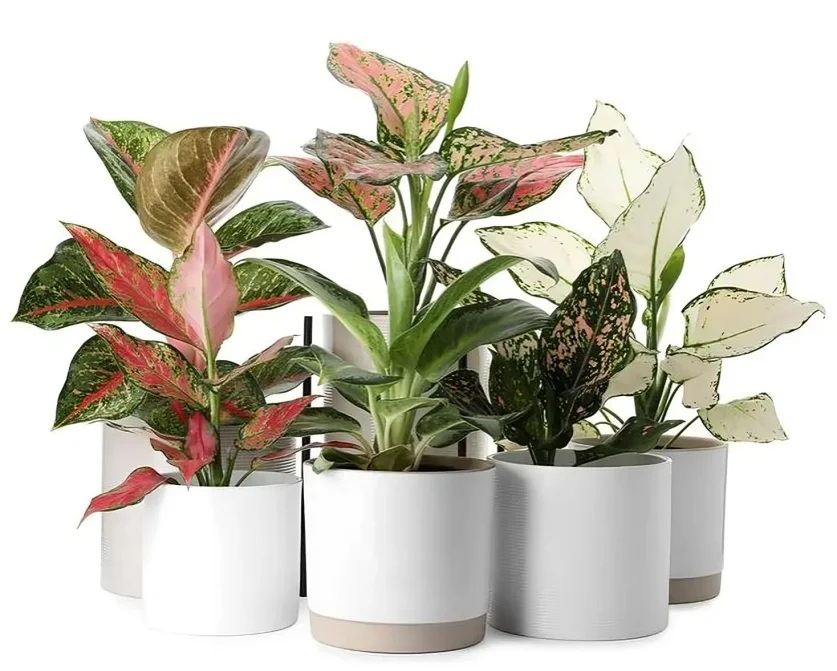Chinese Evergreen, scientifically known as Aglaonema, is a popular indoor plant.
This Chinese Evergreen Care Guide explains everything about care, varieties, and benefits.
Chinese Evergreen (Aglaonema) is a low-maintenance indoor plant. It thrives in low light, prefers well-draining soil, and needs moderate watering. With warm temperatures, balanced feeding, and occasional pruning, this plant stays healthy. It offers beautiful foliage, purifies indoor air, and is perfect for beginners.
Overview of Chinese Evergreen
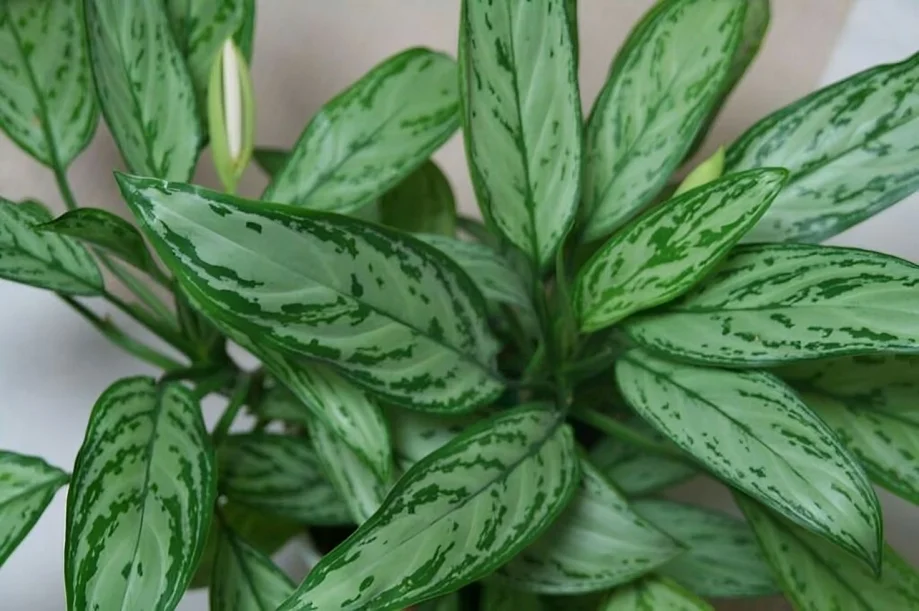
Botanical Background & Varieties
Aglaonema is native to tropical Asia and belongs to the Araceae family.
It has been cultivated for centuries as both an ornamental and air-purifying plant.
Varieties like Silver Queen, Siam Aurora, and Red Emerald are highly sought-after.
They differ in leaf patterns, ranging from silver streaks to red or pink hues.
Appearance & Distinguishing Features
Leaves are glossy, lance-shaped, and may be green, silver, or multicolored.
Compact growth makes it suitable for homes, offices, and small indoor spaces.
Some cultivars grow upright, while others form bushy clusters with many shoots.
Their bold foliage adds vibrancy and life to any interior décor style.
Light, Temperature & Soil Requirements
Light Needs for Chinese Evergreen Care Guide
It grows in low light but thrives in indirect bright light.
Darker varieties adapt well to shaded rooms, while variegated types need brightness.
Direct sun should be avoided since it causes sunburn and leaf discoloration.
Therefore, east or north-facing windows are excellent spots for placement.
Temperature & Humidity Needs
This plant prefers temperatures between 65°F and 80°F for steady growth.
It struggles when exposed to cold drafts or sudden temperature changes indoors.
Additionally, Chinese Evergreen enjoys moderate humidity and responds well to misting.
Placing it near humidifiers or pebble trays helps during dry winter months.
Soil & Potting Mix
The best soil mix is light, airy, and rich in organic matter.
A combination of peat moss, perlite, and compost ensures proper drainage.
Dense or soggy soil should be avoided since it increases root rot risk.
Repotting every two years provides fresh nutrients and supports healthier roots.
Watering & Feeding Chinese Evergreen
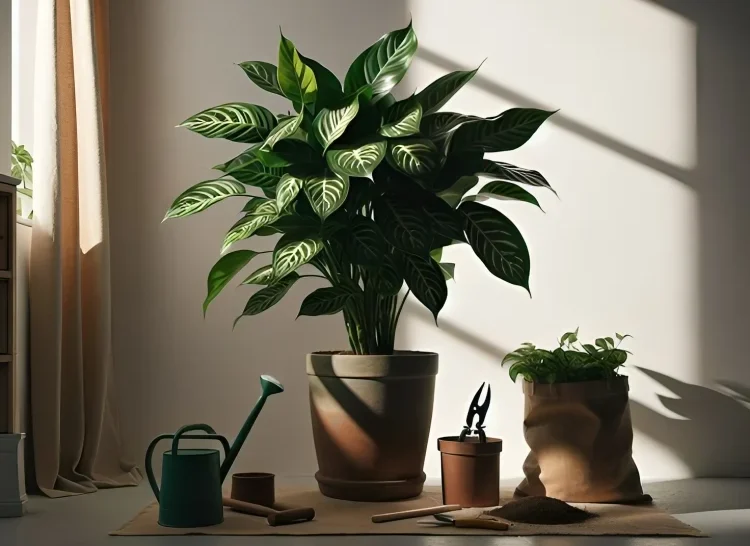
Water Schedule
Water the Chinese Evergreen when the top inch or two of soil dries.
Consistent overwatering causes yellowing leaves, soggy soil, and root rot problems.
Signs of underwatering include drooping stems, curled leaves, and crispy tips.
Hence, always check soil moisture before adding water to the pot.
Fertilization Tips
Feed every month during spring and summer with a diluted liquid fertilizer.
Balanced houseplant fertilizers encourage growth and stronger leaf coloration.
During fall and winter, reduce fertilization as growth naturally slows.
Overfeeding may damage roots, so always follow the recommended guidelines carefully.
Propagation & Repotting Chinese Evergreen
Propagation Methods
It propagation can be done through stem cuttings or root division.
Cuttings rooted in water or soil usually develop roots within several weeks.
Division is often easiest when repotting mature plants with multiple stems.
Each divided clump grows quickly and retains the original plant’s traits.
Repotting Guidelines
Repot Chinese Evergreen when roots become crowded or soil compacts heavily.
Choose a pot one or two inches wider with proper drainage holes.
Spring or summer is the best time since plants actively produce new growth.
Repotting not only improves root health but also refreshes soil nutrients.
Common Problems & Troubleshooting
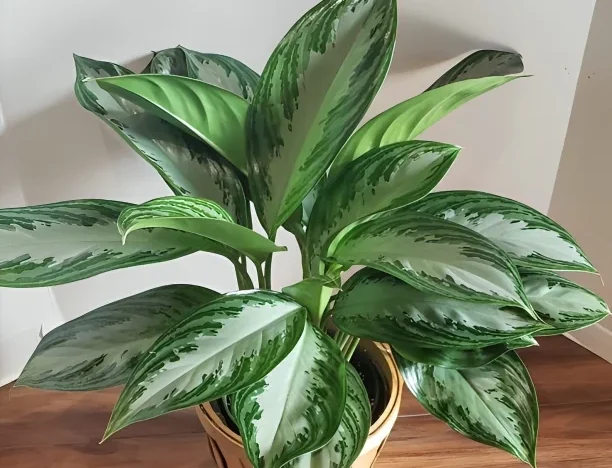
Pests Affecting Chinese Evergreen Care Guide
Spider mites, mealybugs, and scale insects occasionally infest Aglaonema leaves.
Leaves may show sticky residue, webbing, or white cotton-like spots.
Clean foliage with neem oil spray or mild insecticidal soap regularly.
Additionally, wiping leaves with a damp cloth prevents pest build-up effectively.
Diseases & Leaf Issues
Overwatering leads to fungal diseases, root rot, and yellowing foliage.
Browning tips indicate dry air, underwatering, or excessive fertilizer salts.
Drooping leaves may result from improper lighting or sudden cold drafts.
Therefore, always adjust care routines promptly when symptoms appear.
For detailed disease troubleshooting, see The Spruce’s plant care guide.
Safety & Benefits of Chinese Evergreen
Toxicity to Pets & Children
It contains calcium oxalate crystals, toxic if ingested.
Cats, dogs, and small children may experience irritation and swelling.
Keep plants out of reach to ensure a safe household environment.
If ingestion occurs, consult a doctor or veterinarian immediately.
Benefits of Aglaonema
Aglaonema is on NASA’s list of top air-purifying houseplants. It removes harmful indoor toxins like formaldehyde and benzene naturally, improving indoor air quality with ease.
Furthermore, it enhances décor with attractive foliage and easy maintenance. Therefore, it is both a stylish and functional indoor plant choice. For plant lovers exploring other houseplants, it’s also worth learning why peace lily leaves turn yellow, as both Aglaonema and Peace Lily share similar care requirements.
Varieties & Decorative Uses
Popular Aglaonema Cultivars
-
Silver Queen – Elegant silver-striped leaves, classic and adaptable.
-
Siam Aurora – Bright red margins and green centers, striking appearance.
-
Maria Christina – Compact plant with silver and green variegation.
-
Red Emerald – Rich green leaves with prominent red veins.
Each variety requires similar care but differs in lighting preferences slightly.
Decorative Placement Ideas
Place Chinese Evergreen in shaded living rooms, hallways, or office corners.
Pair with tall plants like Fiddle Leaf Fig or Monstera for balance.
Decorative ceramic pots enhance leaf patterns and brighten indoor décor.
Group different Aglaonema cultivars together for a tropical indoor vibe.
Chinese Evergreen Care Guide – Quick Checklist
| Care Factor | Recommendation |
|---|---|
| Light | Bright, indirect; tolerates low light |
| Water | When the top 1–2 inches are dry |
| Soil | Well-draining mix of peat, perlite, and compost |
| Temperature | 65°F–80°F, away from drafts |
| Humidity | Moderate; mist leaves or use a humidifier |
| Fertilizer | Balanced liquid monthly during growing season |
| Repotting | Every 2 years in spring or summer |
| Propagation | Stem cuttings or root division |
| Safety | Toxic to pets and children |
This summary table provides a quick guide for beginner plant owners.
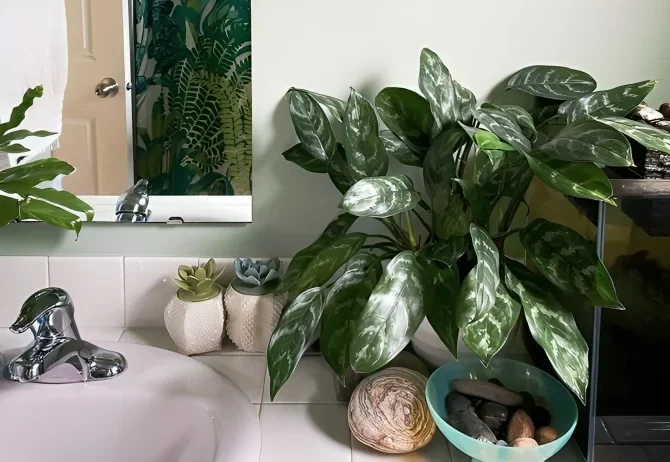
Chinese Evergreen Care Guide: Conclusion
This Chinese Evergreen Care Guide explained light, soil, watering, and propagation; moreover, it highlighted benefits, toxicity concerns, and troubleshooting tips. In fact, Chinese Evergreen is one of the easiest indoor plants for beginners; additionally, it thrives in low light and requires little care. Furthermore, it adapts to changing indoor conditions, and as a result, busy people can enjoy vibrant foliage.
However, owners should avoid overwatering; similarly, maintaining proper humidity ensures glossy leaves. Although toxic to pets, careful placement keeps it safe; instead, focus on its resilience and beauty. For plant lovers dealing with similar challenges, such as understanding why fiddle fig leaves fall, this guide offers valuable comparisons to improve overall indoor plant care.
Meanwhile, decorative pots enhance their appeal and, consequently, make them both functional and stylish. Overall, it combines elegance with practicality; thus, it is a perfect low-maintenance choice. Finally, add one today to improve air quality and bring lasting indoor color.
Chinese Evergreen Care Guide: FAQs
Is Chinese Evergreen easy to care for?
Yes, it tolerates neglect, grows in low light, and adapts to indoor conditions.
Why are Chinese Evergreen leaves turning brown?
Browning tips usually result from low humidity, underwatering, or salty soil.
Can Chinese Evergreen live under artificial light?
Yes, darker cultivars grow well in offices with fluorescent lighting.
How tall does Aglaonema grow indoors?
Depending on the variety, it reaches one to three feet in height.

